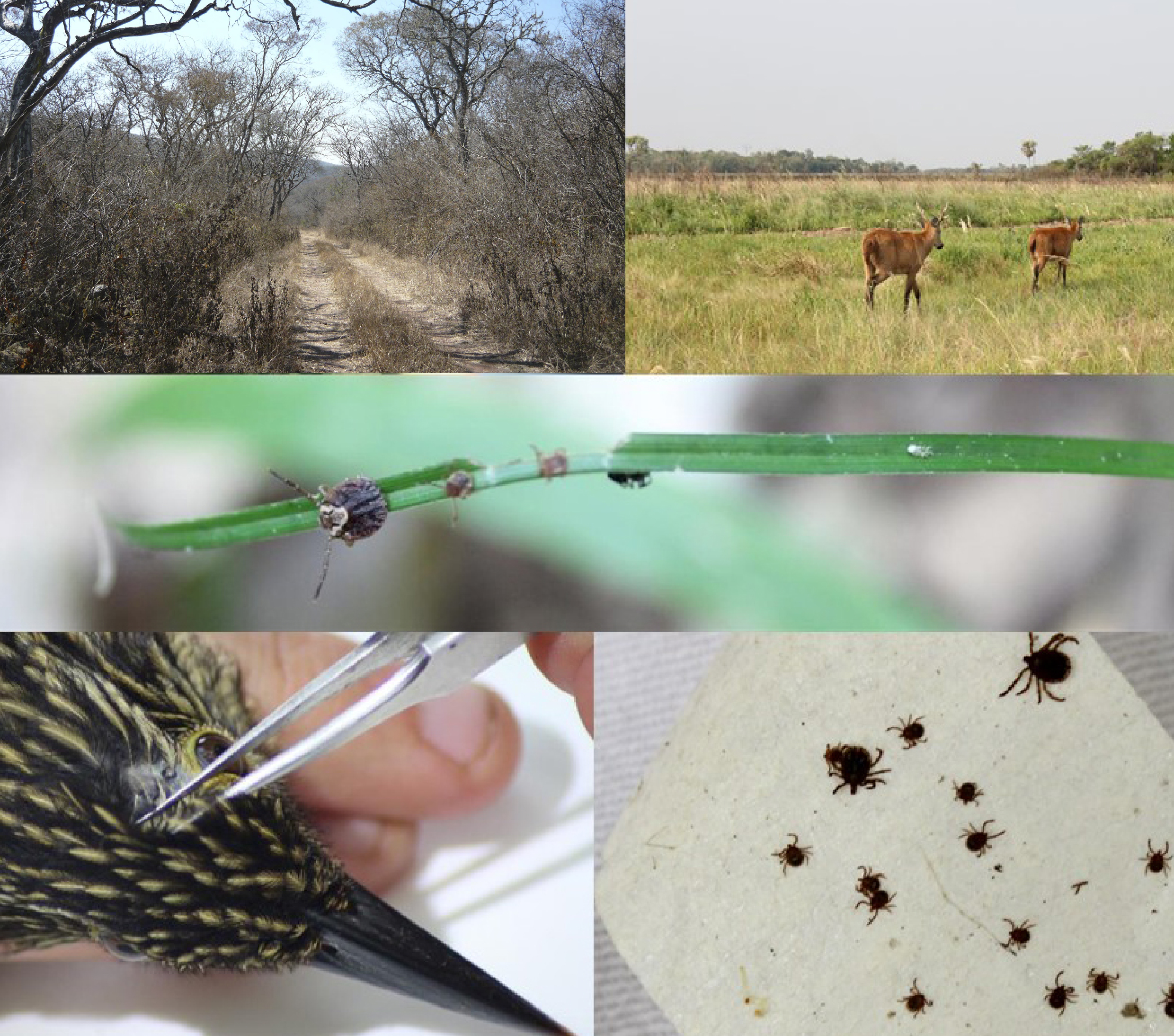Study of the presence of Borrelia spp. in ticks of the genus Amblyomma from Argentina
Búsqueda de Borrelia spp. en garrapatas del género Amblyomma de Argentina

Show authors biography
Objetive. The aim of the present study was to detect Borrelia spp. in different species of ticks of the genus Amblyomma from Argentina. Materials and methods. Amblyomma tick specimens collected from various provinces of Argentina (Entre Ríos, Misiones, Formosa, Salta, Córdoba, San Luis and Buenos Aires) were analyzed by nested PCR for a 306 bp fragment of the gene fla of the genus Borrelia. Results. A total of 422 tick specimens (Amblyomma aureolatum, Amblyomma brasiliense, Amblyomma ovale, Amblyomma sculptum, Amblyomma tigrinum, Amblyomma tonelliae and Amblyomma triste) from various regions of Argentina were studied. All samples were negative by PCR for a fragment of the gene fla of Borrelia spp. Conclusions. The tick species of the genus Amblyomma analyzed in the present study are important for public health; although infection with bacteria of the genus Borrelia was not detected. However, considering the few previous antecedents in the region, future studies on this genus of ticks are necessary.
Article visits 733 | PDF visits
Downloads
- Nava S, Venzal JM, González Acuña D, Martins TF, Guglielmone AA. Ticks of the Southern Cone of America: Diagnosis, Distribution and Hosts with Taxonomy, Ecology and Sanitary Importance. London: Academic Press; 2017.
- Margos G, Gofton A, Wibberg D, Dangel A, Marosevic D, Loh SM, et al. The genus Borrelia reloaded. PLoS One. 2018; 13(12):1–14. https://doi.org/10.1371/journal.pone.0208432
- Cicuttin GL, De Salvo MN, Venzal JM, Nava S. Borrelia spp. in ticks and birds from a protected urban area in Buenos Aires city, Argentina. Ticks Tick Borne Dis. 2019; 10(6):101282. https://doi.org/10.1016/j.ttbdis.2019.101282
- Lee JK, Smith WC, McIntosh C, Ferraric FG, Moore Hendersond B, Varela Stokes A. Detection of a Borrelia species in questing Gulf Coast ticks, Amblyomma maculatum. Ticks Tick Borne Dis. 2014; 5(4):449–452. https://doi.org/10.1016/j.ttbdis.2014.02.004
- Pacheco A, Cordeiro MD, Cepeda MB, Luz HR, Cardozo SV, Berto BP, et al. Hemoparasites in ticks of wild birds of Serra dos Órgãos National Park, state of Rio de Janeiro, Brazil. Brazilian J Vet Parasitol. 2019; 28(2). https://doi.org/10.1590/s1984-29612019017
- Barbour AG, Maupin GO, Teltow GJ, Carter CJ, Piesman J. Identification of an uncultivable Borrelia species in the hard tick Amblyomma americanum: possible agent of a Lyme disease-like illness. J Infect Dis. 1996; 173(2):403–409. https://doi.org/10.1093/infdis/173.2.403
- James AM, Liveris D, Wormser GP, Schwartz I, Montecalvo M a, Johnson BJ. Borrelia lonestari infection after a bite by an Amblyomma americanum tick. J Infect Dis. 2001; 183 (12):1810–1814. https://doi.org/10.1093/infdis/173.2.403
- Binetruy F, Garnier S, Boulanger N, Talagrand-reboul É, Loire E, Faivre B, et al. A novel Borrelia species, intermediate between Lyme disease and relapsing fever groups, in neotropical passerine-associated ticks. Sci Rep. 2020; 10:10596. https://doi.org/10.1038/s41598-020-66828-7
- Colunga-Salas P, Sánchez-Montes S, Ochoa-Ochoa LM, Grostieta E, Becker I. Molecular detection of the reptile-associated Borrelia group in Amblyomma dissimile, Mexico. Medical and Veterinary Entomology. 2020; 52:1-5. https://doi.org/ 10.1111/mve.12478
- dos Santos CA, Suzin A, Vogliotti A, Nunes PH, Barbieri ARM, Labruna MB, et al. Molecular Detection of a Borrelia sp. in nymphs of Amblyomma brasiliense ticks (Acari: Ixodidae) from Iguaçu National Park, Brazil, genetically related to Borrelia from Ethiopia and Côte D’Ivoire. Ticks Tick Borne Dis. 2020; 11(6):101519. https://doi.org/10.1016/j.ttbdis.2020.101519
- Cicuttin G, Nava S. Molecular identification of Rickettsia parkeri infecting Amblyomma triste ticks in an area of Argentina where cases of rickettsiosis were diagnosed. Mem Inst Oswaldo Cruz. 2013; 108(1):123–125. http://dx.doi.org/10.1590/S0074-02762013000100022
- Cicuttin GL, De Salvo MN, Nava S. Two novel Ehrlichia strains detected in Amblyomma tigrinum ticks associated to dogs in peri-urban areas of Argentina. Comp Immunol Microbiol Infect Dis. 2017; 53:40–44. https://doi.org/10.1016/j.cimid.2017.07.001
- Cicuttin GL, Salvo MN De, Pérez PD, Silva D, Félix L, Venzal JM, et al. A novel Ehrlichia strain (Rickettsiales: Anaplasmataceae) detected in Amblyomma triste (Acari: Ixodidae), a tick species of public health importance in the Southern Cone of America. Pathog Glob Health. 2020; 114(6):318-322. https://doi.org/10.1080/20477724.2020.1795579
- Lamattina D, Tarragona EL, Nava S. Molecular detection of the human pathogen Rickettsia parkeri strain Atlantic rainforest in Amblyomma ovale ticks in Argentina. Ticks Tick Borne Dis. 2018; 9(5):1261–1263. https://doi.org/10.1016/j.ttbdis.2018.05.007
- Mastropaolo M, Tarragona EL, Silaghi C, Pfister K, Thiel C, Nava S. High prevalence of “Candidatus Rickettsia amblyommii” in Amblyomma ticks from a Spotted Fever Endemic Region in North Argentina. Comp Immunol Microbiol Infect Dis. 2016; 46:73–76. http://dx.doi.org/10.1016/j.cimid.2016.05.001
- Tarragona EL, Cicuttin GL, Mangold AJ, Mastropaolo M, Salvo MN De, Nava S. Rickettsia infection in Amblyomma tonelliae, a tick species from the Amblyomma cajennense complex. Ticks Tick Borne Dis. 2014; 6(2):173–177. http://doi.org/10.1016/j.ttbdis.2014.11.010
- Stromdahl EY, Nadolny RM, Hickling GJ, Hamer SA, Ogden NH, Casal C, et al. Amblyomma americanum (Acari: Ixodidae) ticks are not vectors of the Lyme Disease agent, Borrelia burgdorferi (Spirocheatales: Spirochaetaceae): A review of the evidence. J Med Entomol. 2018; 55(3):501-514. http://doi.org/10.1093/jme/tjx250
- Eisen L. Vector competence studies with hard ticks and Borrelia burgdorferi sensu lato spirochetes: A review. Ticks Tick Borne Dis. 2020; 11(3):101359. https://doi.org/10.1016/j.ttbdis.2019.101359























